Bill Schenley
2006-08-02 21:08:28 UTC
Yankees' Thurman Munson Killed Piloting His Own Small Jet In Ohio
Photo: Loading Image...
FROM: The New York Times (August 3rd 1979) ~
By Jim Naughton
Thurman Munson, the 32-year-old catcher and team captain of the New York
Yankees, was killed yesterday when the plane he was piloting crashed short
of the runway while trying to land at the Akron-Canton Airport in Ohio.
Two passengers who were flying with him were taken to local hospitals where
they were reported in fair condition.
Mr. Munson's Cessna Citation twin-engine jet crashed outside the perimeter
of the airport and came to rest 200 feet north of runway 19 at 3:02 P.M.,
Eastern daylight time, according to the Akron police.
Federal Aviation Administration officials said the plane had lost its wings
and burst into flames after the crash, resulting in injuries to two
occupants and the death of the third.
Anthony Cardarelli, sheriff of Summit County, confirmed that Mr. Munson was
the one who was killed.
One of the two passengers, David Hall, 32, of Canton, who first taught Mr.
Munson to fly, was reported in fair condition with burns on his arms and
hands at the Akron Burn Center at Children's Hospital. The other passenger,
Jerry D. Anderson, also of Canton, was reported in fair condition with burns
of the face, arms and neck at Timkin Mercy Hospital in Canton.
The F.A.A. authorities said the cause of the crash was unknown. Detective
William Evans, who arrived at the scene five minutes after the crash said
witnesses told him the jet began clipping trees as it approached the runway.
It touched down just north of Greensburg Road, he said. Motorists had to
"break for the plane," he added. "It's a miracle people weren't injured
during that time of the rush hour."
Mr. Evans said Mr. Hall was in the co-pilot seat, but "Munson had the plane
to himself."
"Both victims tried valiantly to get Munson out," Mr. Evans added. He said
the two men had about 30 seconds to try to free the Yankee star before the
plane "went up in flames." One victim kicked out the emergency door while
the other tried to pull Mr. Munson free. They succeeded in removing him
from the pilot's seat, investigators said. However, Mr. Evans said that
when the door opened "fuel, which was stored in the wing, ignited and
engulfed the plane."
The two men tried to free Mr. Munson again, Mr. Evans said, "but the fire
got so bad they had to get out. I think some of their clothes were on
fire."
Carl Santelli, a friend of Munson's in Canton, said the Yankee star had come
in from Chicago at 3 A.M. yesterday. "He said the plane wasn't acting
right," said Mr. Santelli, "and he was going out to find out what was wrong
with it."
A Cessna spokesman said the plane, which was lettered NY15, corresponding to
its owner's Yankee jersey number, was the first Citation in the country to
be involved in an accident.
Neal Callahan of the F.A.A.'s Chicago office said the plane "had some
touch-and-go practice takeoffs and landings" when the crash occurred.
Munson, a native of Akron, often flew home during home stands and road trips
to be with his family. A Yankee coach, Elston Howard, said Munson told him
he was interested in running a commercial commuter airline and was studying
for a special license.
The coach said Mr. Munson wanted to stay as close to his family as possible.
"That's why he told me he was flying home on his own plane on off days. He
just said, 'Ellie, I want to see my family.' That's what he told me."
Munson, who batted over .300 five times and played on three Yankee pennant
winners and two world championship teams, was the first Yankee captain since
Lou Gehrig.
In his autobiography, written in 1978, he had described his love of flying.
"I have a new love to make things somewhat more pleasant for me this year -
airplanes. I studied for my pilot's license and received it during the
winter. Now ... it's possible to fly from New York to Canton in about an
hour and I frequently go home even during home stands."
The police were at his home in Canton, where Mr. Munson's wife, Diane, and
the couple's three children, Tracy Lynn, 9; Kelly, 7, and Michael, 4,
received news of the crash.
John Habermann, a flight instructor at Teterboro Airport in Bergan County,
N.J., said he considered Mr. Munson "a fine pilot."
"He would study his airplane well," Mr. Habermann said. "He took it very
seriously and was a very dedicated pilot."
News of the death shocked the baseball world.
The Yankees principal owner, George Steinbrenner, said in a statement:
"There's very little I could say to adequately express my feelings at this
moment. I've lost a dear friend, a pal and one of the greatest competitors
I've ever known. We spent many hours together talking baseball, and
business. He loved his family. He was our leader. The great sport that
made him so famous seems so very small and unimportant now."
Martin Loved Him
Billy Martin, the Yankee manager, said: "For those who never knew him and
didn't like him, I feel sorry for them. He was a great man, for his family
and all the people who knew and loved him, my deepest sympathy. We not only
lost a great competitor, but a leader and a husband and devoted family man.
He was a close friend, I loved him."
Commissioner Bowie Kuhn called the crash "an almost indescribable loss."
"He was a wonderful enormously likable guy and a truly great ballplayer,"
the commissioner said. "As tough a competitor as he was on the field he was
a warm friend of baseball people and a loving family man. Baseball sends
its heartfelt sympathy to his wife and children."
Gabe Paul, the former Yankee president, said he was shocked. "I coveted him
as a player. That goes without saying. I just keep thinking to myself how
much he wanted to play here and how close he would have been to home."
Cleveland is about 45 miles from Canton.
Munson was an all-American catcher at Kent State in 1968. He came to the
Yankees in 1969 and was rookie of the year in 1970. He won a Gold Glove
Award in 1973, 1974 and 1975. He won the American League Most Valuable
Player Award in 1976 and was named captain of the Yankees that year.
The Yankees have scheduled a team meeting today to decide what action to
take. The funeral will be held in Canton. Arrangements are indefinite.
---
More on the life and death of Thurman Munson ~
Thurman Munson Was Proud Captain of the Yankees (By Murray Chass):
Loading Image...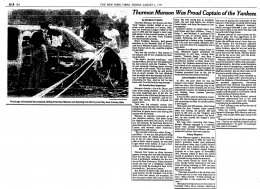
The Short, Enigmatic Life of Thurman Munson (By Dave Anderson):
Loading Image...
You Can't Look It Up:
Loading Image...
Yankee Teammates In Munson Tributes (Special to The New York Times):
Loading Image...
Fans Cheer Before Loss (By Murray Chass):
Loading Image...
Loading Image...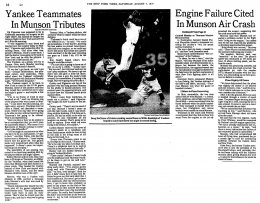
Face on the Scoreboard (By Dave Anderson):
Loading Image...
Engine Failure Cited by Investigator As Apparent Cause of Munson Crash (By
James Tuite):
Loading Image...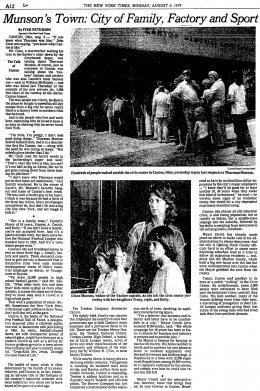
Loading Image...
The Tragedy of Two Yankee Captains (By Dave Anderson):
Loading Image...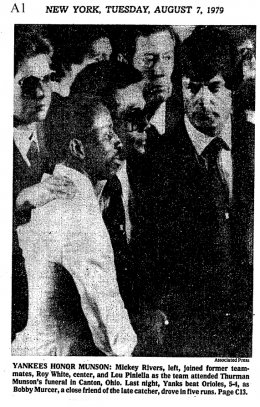
Study of Munson Plane Crash Intensified (AP):
Loading Image...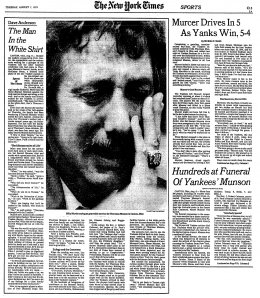
Nobody to Talk to Now (By Joseph Durso):
Loading Image...
Munson wanted to Play for Indians But Loved Game Too Much to Quit (By
Thurman Munson):
Loading Image...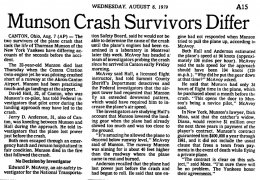
The Yankees Nightmare Season (By Dave Anderson):
Loading Image...
Loading Image...
Munson's Town: City of Family, Factory and Sport (By Iver Peterson):
Loading Image...
Munson Touched The Kids (By Jim Naughton):
Loading Image...
The Man in the White Shirt (By Dave Anderson):
Loading Image...
Murcer Wins One For Yankees:
Loading Image...
Murcer Drives In 5 As Yanks Win, 5-4 (By Murray Chass):
Loading Image...
Loading Image...
Hundreds at Funeral Of Yankees' Munson (Special to The New York Times):
Loading Image...
Loading Image...
Munson Crash Survivors Differ (AP):
Loading Image...
A Scoreboard Message That Touched All (By Jamie Malanowski):
Loading Image...
---
Photo:
Loading Image...
Hero's Death; Survivor's Story
FROM: ESPN.com (July 30th 2004) ~
By Willie Weinbaum and Tim Rinaldi
Old-Timers Day, a summer Saturday, and fans in Yankee colors fill the
sidewalks and streets around the old ballpark in the Bronx.
Under the elevated subway station, out beyond Monument Park, business is
bustling. Stores showcase "15 Munson" shirts alongside "3 Ruth" ... "4
Gehrig" ... "5 DiMaggio."
Countless toddlers are wearing "15 Munson," many with parents too young to
really remember the catcher, captain and anchor of the '70s teams that
restored Yankee glory.
Thurman Munson never became an old-timer.
The story always seemed so straightforward and accessible. Unshakable
determination borne through years of unreasonable demands from his father. A
Norman Rockwell family life in a dream house with his childhood sweetheart
and their three children. An accelerated pursuit of a pilot's license to
spend more time at home in Canton, Ohio.
From a beer league mien to an indomitable persona, Munson's image and legacy
are indelible. So, too, are the scenes following his death 25 years ago on
Aug. 2.
The empty catcher's box ... The scoreboard photo of Munson, frizzy hair
escaping beneath his cap, towering over a tearful Reggie Jackson in right
field ... A devastated Billy Martin at the funeral ... Bobby Murcer's
magical "walkoff" performance on national TV the night of the funeral, a
generation before walkoffs entered the lexicon.
Raw emotion and stirring tributes a quarter-century ago ingrained in us a
collective sense of the ballplayer, husband and father, and the cruelty of a
life lost at 32.
To the press, Munson was brusque and aloof, and the exchanges were more
often profane than profound. But columnists and documentarians alike have
painted expansive and glowing portraits. The first Yankee captain since
tragedy took the Iron Horse, Lou Gehrig, Munson was a round model of smarts
behind the plate and prowess beside it, especially in the clutch. A proud
adversary to the "straw that stirred the drink."
But what hadn't we learned through the tributes, the tell-all tomes on the
"Bronx Zoo," and the uplifting visits through the media with Munson's
family, every five years or so?
"There is one thing," Munson biographer Marty Appel said this spring. "One
thing that hasn't been done on Thurman. Two guys survived the plane crash
and neither has ever been interviewed about it."
A career after baseball
"If it's a tribute, I might like to be a part of it," Jerry Anderson said in
May. Reluctant to recount on camera the horror of the crash, Anderson said
the time could finally be right to share his stories, including the ultimate
tribute -- what Munson said and did, just before he died.
David Hall was Munson's flight instructor, before Munson upgraded from props
to a jet. In May, Hall politely declined comment about the Aug. 2, 1979
flight he took with Anderson and Munson, the final flight of Munson's life.
A year younger than Munson, Anderson met him in the mid-'70s on the handball
courts at the Canton YMCA. They became friends and business partners in
commercial real estate.
Off the field, Anderson said, Munson was as prescient as he was in
first-guessing baserunners trying to steal.
"He was always playing two plays or two volleys or two shots, as we call 'em
in handball, ahead. And I realized that he had it in real estate. He was
able to see what was going to happen to an area prior to a lot of people. It
was almost as if he had a peek into the future."
When Anderson recruited Munson to invest with him in a chain of racquetball
clubs, Munson didn't just demur, he told Anderson to divest or he would pull
out of a planned venture to involve other ballplayers in real estate.
Anderson sold his racquetball interest before it went bust. After Munson
died, and the injured Anderson was out of work, "the cash from the deal
saved me from going broke."
Munson was motivated to master high finance, said Anderson. "He said, 'I
need to make sure, that when I am finished playing baseball, I could provide
for my family. I don't want to be just a dumb jock. I want to be a
businessman; somebody that understands the economic ways of the world and I
can use baseball as a way to launch myself into my next career.' "
With his first career likely approaching its twilight, Munson developed a
passion for piloting and often flew with Anderson, also a pilot, to inspect
investment properties. "This was an intense, focused man. Aviation was no
different. When he dove into aviation, he dove in headfirst, and by that I
mean he devoured it, he studied it," Anderson said.
Passion for flying
By all accounts, Munson was a skillful pilot, especially impressive to his
wife, Diana. "I personally don't like flying at all. So, obviously, this was
difficult for me. It was a tribute to Thurman and to my love for him that I
would go with him. But I was totally comfortable, felt totally safe with
him. We even took our children."
In a year and a half of flying, Munson bought four planes,culminating on
July 6, 1979 with the purchase of a Cessna Citation 501. Emblazoned with his
Yankee number, "N15NY" was a blue and white seven-seat, twin-engine,
million-dollar jet.
"Too powerful. I mean, it scared me," said Lou Piniella, Munson's teammate
and friend, who had flown with him before he bought the jet.
"He had asked me to fly many, many times with him and I used to tell him,
'you don't have enough hours for me,' " said Bobby Murcer, another teammate
and friend.
Munson was certified to fly the Citation on July 17, 1979, just 11 days
after he bought it.
Two weeks later, the Yankees were in Chicago for a series with the White
Sox. Munson and Piniella were at Murcer's Chicago home when the conversation
turned to the new plane. "Bobby and I did our best to convince him that,
'Look, just get rid of the jet,' " recalls Piniella.
After a day game on Aug. 1, Murcer drove Munson to a small Chicago-area
airport, and watched him take off alone, for an off-day at home. "He revved
the engines up and took off, and actually just took off above me where I was
sitting in my car. It was night time, I could not believe that Thurman was
actually in that powerful machine all by himself, you know. And the darkness
of the night."
The next afternoon Munson went back to Akron-Canton Regional Airport, where
he arrived the night before, to tinker with his new jet and practice
takeoffs and landings. By chance, he met Jerry Anderson and David Hall, and
showed off the new plane.
The memory brings a smile to Anderson. "You'd have thought it was a newborn
child. We walked around that airplane, and he patted it, and he stroked it,
and he showed it to me. He said, 'I am so proud of this. This is something
that's going to enable us to really come back and forth. And I am going to
be able to see my family more.' And he said, 'Look at that. Look at that
tail number.' And that's when he pointed to '15NY.'"
Munson invited the two men for a short flight aboard N15NY. "I couldn't wait
to go up in it," Anderson said.
Hall sat alongside Munson in the cockpit; Anderson behind them in the cabin.
The entire flight that day was less than half an hour.
The details are in a 27-page National Transportation Safety Board
investigation report, available on the Internet.
But only a survivor can complete the story.
'Are you guys OK?'
At 3:41 p.m., Munson, cleared by the control tower for takeoff on Runway
2-3, embarked on a left-traffic pattern. Over the next 15 minutes, he
performed three routine landings and takeoffs.
After the third takeoff, the tower instructed Munson to shift to a right
traffic pattern, for a landing on runway 1-9. But this approach was
different.
David and I both noticed the same thing -- that we were a little bit lower
than what we had been on previous landings. No big deal," Anderson said. "On
final approach, you always have to adjust upwards or downwards."
Recognition changed to concern.
"We were now descending towards 1-9 relatively rapidly. And I felt a
sinking."
The plane dropped to roughly 500 feet above the ground. Munson lowered the
landing gear, causing the descent to steepen.
"I realized that this descent was probably not going to be arrested and that
we would probably crash short of the runway," Anderson said. "You had a
second to prepare yourself. A second to prepare yourself for impact."
At 4:02 p.m., the plane struck ground about 1,000 feet short of runway 1-9
in a field dotted with small trees.
"I felt the fuselage just taking the pounding, BOOM! BOOM! BOOM! BOOM!"
Anderson claps as he accentuates the recollection of each impact.
After skidding through the field and slamming into an immense tree stump,
the plane came to rest atop a two-lane road, some 600 feet short of runway
1-9. Munson's legs were pinned. He was bloody, but conscious.
"I realized, as we came to a stop, that I was still intact. I mean,
unbelievable as it might seem, I thought, 'My God, I have survived this,'
Anderson said. "I looked up to the cockpit, David was moving, and Thurman's
head was twisted a little bit. I thought, 'This is unbelievable. We are
going to walk away from this airplane.
We have just crashed an airplane, and we have all survived.'
"Things didn't quite go like my mind had initially thought. The right side
of the aircraft was engulfed in flames, but I was feeling pretty good about
it, because the right side of the aircraft was not the side of the aircraft
we needed to go out. The door was on the left side. And the left side was
relatively clear. I didn't see any smoke or flames there."
The left side, with the accessible door, was Anderson's side.
"What I quickly realized is, I could not get it open. The door had jammed.
David came back, and he gave it a try, and he couldn't get it open either. I
took a good solid kick at it. And now, as I think about it, it was probably
ridiculous that I thought I should have been able to kick open that door.
"At that point, the aircraft has started to fill with smoke.
"I will hang on this for a long time ... Thurman mumbled to us. He said,
'Are you guys OK?' At this point, he said, 'Are you guys OK?' We said,
'Yeah.' I don't remember whether David said it, or I said it. But one of us
said, 'How about you?' He said, 'I don't know. I can't move. I can't move.'
"
Those were the final words of Munson's life. But Anderson, of course, did
not know it.
"Almost instinctively, David and I split up the responsibilities. I was
closest to the door. Obviously, I needed to get us out of there. He was
closest to Thurman, he was going to lift Thurman up. We felt that we could
probably collectively get him out of there.
"The communication that we had -- and this is all in seconds -- was let's
go, let's get us all out of here."
With the main door jammed, the only escape route was an emergency exit on
the right.
"When I cracked the emergency door, flames shot in and above our heads into
the cockpit," said Anderson of an area that's only about four feet wide.
There was still hope for the passengers to rescue the pilot.
"We are going to get him out of there. We are just going to haul him out. I
mean, it's no big deal. There are two of us, there is one of him," Anderson
said. "But what I quickly realized was, when the flames came into the
cockpit, and started to catch fire in the air, the black smoke was so
overtaking, we couldn't really breathe. At that point, we didn't have a
choice."
Munson was unconscious. Just minutes after the crash, time was running out
on the efforts to move him toward the emergency exit.
Without discussion, a decision: Escape.
"Unspoken word. I pulled the emergency door into the cockpit ... and pretty
much dove into the puddle of fuel that was on fire on the right side.
"As I was departing the aircraft, David gave one last tug on Thurman, and he
couldn't move him. Neither one of us could move him. David followed me,
right outside that door. I rolled around on the ground for a moment, and
then was unconscious. I don't really remember anything after that, until
waking up in the hospital.
"The hard part of that, of course, is that there was a point in time that I
knew that I was going to leave that airplane, and that my friend was not.
And that was a terrible feeling."
Munson, his neck broken from the impact of the crash, overcome by heat and
smoke, was pronounced dead at the scene.
'Thurman always seemed bigger than life'
A mother of three young children, Diana Munson was suddenly a widow at 31.
"The fact that Thurman was gone, and that the two other fellows were in an
airplane, but they were still here, seemed impossible for me to believe.
Because Thurman always seemed bigger than life to me," Diana said.
She sought out Anderson and Hall, both of whom were in the hospital with
severe burns, to check on their condition, and ease their burden.
"I wanted them to know that I wasn't placing blame, and that I was not
sitting in judgment in any way because I knew they had to go on with their
lives, too."
Anderson's eyes moisten with the memory.
"When I met with Diana, after the accident, it was so hard to look her in
the eye, and say, 'You know, Diana, we did what we could, to get Thurman out
of there. And we just couldn't do it.' And that was, that was tough then.
That was really tough."
Still a pilot, Anderson continues to fly over the runway he never reached in
N15NY, 25 years ago.
What is it like to land on runway 1-9?
"The first time that I flew after the accident, I was perspiring so
profusely, that I thought I had wet myself," Anderson said. "I was that
nervous.
"Every time I fly on the final approach to 1-9, I have to look down at that
terrible place where we had crashed. Of course, now it's all grown over, and
all the trees are gone, and the stump is removed."
As Anderson came to learn, the stump was of great significance in the
tragedy.
"Our aircraft hit that stump, right on the pilot side. I now know that's why
the door wouldn't open.
"Had that stump hit on the right side of the aircraft, I suspect David would
have probably had the same outcome as Thurman. And I suspect Thurman and I
would have gone out the entrance door. Fate is something one can't explain."
The NTSB explanation for the fatal crash was pilot error.
Among Munson's mistakes, he failed to maintain sufficient air speed for
landing and lowered the landing gear too late.
"When you read that NTSB report, what you realize is that Thurman was a
well-trained, competent pilot, who made a mistake, a couple of pilot errors
that day," Anderson said. "Pilots are human and when pilots make errors,
aviation is not very forgiving."
Right up to the crash, Anderson said, Munson was battling to right the
course.
"Thurman was doing everything possible, as a pilot, to put that aircraft on
the ground safely. He did what he was trained to do. He had full throttles.
He was trying to accelerate and get the airplane climbing again. That day,
it was not to be, though. It was simply not to be."
Anderson repeats the memory that is his greatest tribute to Munson, of a
pilot's dying concern for his friends.
"He said to both David and I, 'Are you guys all right?' He was worried about
us. Imagine that. He's worried about us. Now when I think back on that, it
makes my heart heavy."
Years after the accident, Diana Munson settled a lawsuit charging the
plane's manufacturer and a flight school with inadequate pilot training for
her late husband.
The kids are grown, and she is now considering moving from the Canton home
bought not long before the crash. In part to raise college funds for her
grandchildren, she is selling some of the Yankee captain's artifacts through
the new "Memorabilia Roadshow" run by former players.
On this summer Saturday, the Munson family is back at Yankee Stadium.
With Piniella, Murcer and many of her husband's teammates from 25 years ago
at her side, Diana Munson throws the ceremonial first pitch to a spot just
in front of home plate.
Hours before, in Monument Park, another Munson made a different pitch.
Beneath a plaque honoring his father, the legendary catcher, Michael Munson
knelt to propose marriage to his girlfriend, Michelle Bruey. She accepted.
"He wanted his dad to be a part of it," Diana Munson said, this Old-Timers
Day.
---
Photo:
Loading Image...
1970 Topps (#189) baseball card:
Loading Image...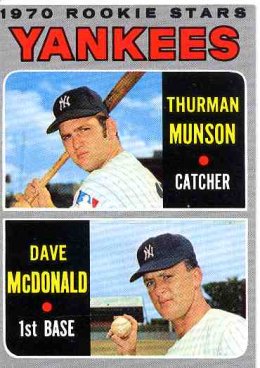
1971 Topps (#5) baseball card:
Loading Image...
1972 Topps (#441) baseball card:
Loading Image...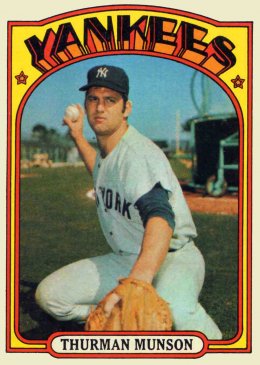
1976 Topps (#650) baseball card:
Loading Image...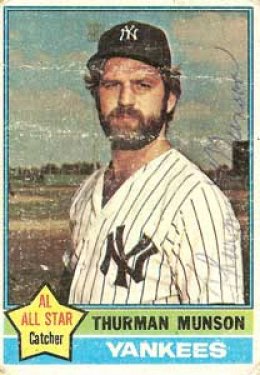
1977 Topps (#170) baseball card:
Loading Image...
Thurman Munson in art:
Loading Image...
Photo: Loading Image...
FROM: The New York Times (August 3rd 1979) ~
By Jim Naughton
Thurman Munson, the 32-year-old catcher and team captain of the New York
Yankees, was killed yesterday when the plane he was piloting crashed short
of the runway while trying to land at the Akron-Canton Airport in Ohio.
Two passengers who were flying with him were taken to local hospitals where
they were reported in fair condition.
Mr. Munson's Cessna Citation twin-engine jet crashed outside the perimeter
of the airport and came to rest 200 feet north of runway 19 at 3:02 P.M.,
Eastern daylight time, according to the Akron police.
Federal Aviation Administration officials said the plane had lost its wings
and burst into flames after the crash, resulting in injuries to two
occupants and the death of the third.
Anthony Cardarelli, sheriff of Summit County, confirmed that Mr. Munson was
the one who was killed.
One of the two passengers, David Hall, 32, of Canton, who first taught Mr.
Munson to fly, was reported in fair condition with burns on his arms and
hands at the Akron Burn Center at Children's Hospital. The other passenger,
Jerry D. Anderson, also of Canton, was reported in fair condition with burns
of the face, arms and neck at Timkin Mercy Hospital in Canton.
The F.A.A. authorities said the cause of the crash was unknown. Detective
William Evans, who arrived at the scene five minutes after the crash said
witnesses told him the jet began clipping trees as it approached the runway.
It touched down just north of Greensburg Road, he said. Motorists had to
"break for the plane," he added. "It's a miracle people weren't injured
during that time of the rush hour."
Mr. Evans said Mr. Hall was in the co-pilot seat, but "Munson had the plane
to himself."
"Both victims tried valiantly to get Munson out," Mr. Evans added. He said
the two men had about 30 seconds to try to free the Yankee star before the
plane "went up in flames." One victim kicked out the emergency door while
the other tried to pull Mr. Munson free. They succeeded in removing him
from the pilot's seat, investigators said. However, Mr. Evans said that
when the door opened "fuel, which was stored in the wing, ignited and
engulfed the plane."
The two men tried to free Mr. Munson again, Mr. Evans said, "but the fire
got so bad they had to get out. I think some of their clothes were on
fire."
Carl Santelli, a friend of Munson's in Canton, said the Yankee star had come
in from Chicago at 3 A.M. yesterday. "He said the plane wasn't acting
right," said Mr. Santelli, "and he was going out to find out what was wrong
with it."
A Cessna spokesman said the plane, which was lettered NY15, corresponding to
its owner's Yankee jersey number, was the first Citation in the country to
be involved in an accident.
Neal Callahan of the F.A.A.'s Chicago office said the plane "had some
touch-and-go practice takeoffs and landings" when the crash occurred.
Munson, a native of Akron, often flew home during home stands and road trips
to be with his family. A Yankee coach, Elston Howard, said Munson told him
he was interested in running a commercial commuter airline and was studying
for a special license.
The coach said Mr. Munson wanted to stay as close to his family as possible.
"That's why he told me he was flying home on his own plane on off days. He
just said, 'Ellie, I want to see my family.' That's what he told me."
Munson, who batted over .300 five times and played on three Yankee pennant
winners and two world championship teams, was the first Yankee captain since
Lou Gehrig.
In his autobiography, written in 1978, he had described his love of flying.
"I have a new love to make things somewhat more pleasant for me this year -
airplanes. I studied for my pilot's license and received it during the
winter. Now ... it's possible to fly from New York to Canton in about an
hour and I frequently go home even during home stands."
The police were at his home in Canton, where Mr. Munson's wife, Diane, and
the couple's three children, Tracy Lynn, 9; Kelly, 7, and Michael, 4,
received news of the crash.
John Habermann, a flight instructor at Teterboro Airport in Bergan County,
N.J., said he considered Mr. Munson "a fine pilot."
"He would study his airplane well," Mr. Habermann said. "He took it very
seriously and was a very dedicated pilot."
News of the death shocked the baseball world.
The Yankees principal owner, George Steinbrenner, said in a statement:
"There's very little I could say to adequately express my feelings at this
moment. I've lost a dear friend, a pal and one of the greatest competitors
I've ever known. We spent many hours together talking baseball, and
business. He loved his family. He was our leader. The great sport that
made him so famous seems so very small and unimportant now."
Martin Loved Him
Billy Martin, the Yankee manager, said: "For those who never knew him and
didn't like him, I feel sorry for them. He was a great man, for his family
and all the people who knew and loved him, my deepest sympathy. We not only
lost a great competitor, but a leader and a husband and devoted family man.
He was a close friend, I loved him."
Commissioner Bowie Kuhn called the crash "an almost indescribable loss."
"He was a wonderful enormously likable guy and a truly great ballplayer,"
the commissioner said. "As tough a competitor as he was on the field he was
a warm friend of baseball people and a loving family man. Baseball sends
its heartfelt sympathy to his wife and children."
Gabe Paul, the former Yankee president, said he was shocked. "I coveted him
as a player. That goes without saying. I just keep thinking to myself how
much he wanted to play here and how close he would have been to home."
Cleveland is about 45 miles from Canton.
Munson was an all-American catcher at Kent State in 1968. He came to the
Yankees in 1969 and was rookie of the year in 1970. He won a Gold Glove
Award in 1973, 1974 and 1975. He won the American League Most Valuable
Player Award in 1976 and was named captain of the Yankees that year.
The Yankees have scheduled a team meeting today to decide what action to
take. The funeral will be held in Canton. Arrangements are indefinite.
---
More on the life and death of Thurman Munson ~
Thurman Munson Was Proud Captain of the Yankees (By Murray Chass):
Loading Image...
The Short, Enigmatic Life of Thurman Munson (By Dave Anderson):
Loading Image...
You Can't Look It Up:
Loading Image...
Yankee Teammates In Munson Tributes (Special to The New York Times):
Loading Image...
Fans Cheer Before Loss (By Murray Chass):
Loading Image...
Loading Image...
Face on the Scoreboard (By Dave Anderson):
Loading Image...
Engine Failure Cited by Investigator As Apparent Cause of Munson Crash (By
James Tuite):
Loading Image...
Loading Image...
The Tragedy of Two Yankee Captains (By Dave Anderson):
Loading Image...
Study of Munson Plane Crash Intensified (AP):
Loading Image...
Nobody to Talk to Now (By Joseph Durso):
Loading Image...
Munson wanted to Play for Indians But Loved Game Too Much to Quit (By
Thurman Munson):
Loading Image...
The Yankees Nightmare Season (By Dave Anderson):
Loading Image...
Loading Image...
Munson's Town: City of Family, Factory and Sport (By Iver Peterson):
Loading Image...
Munson Touched The Kids (By Jim Naughton):
Loading Image...
The Man in the White Shirt (By Dave Anderson):
Loading Image...
Murcer Wins One For Yankees:
Loading Image...
Murcer Drives In 5 As Yanks Win, 5-4 (By Murray Chass):
Loading Image...
Loading Image...
Hundreds at Funeral Of Yankees' Munson (Special to The New York Times):
Loading Image...
Loading Image...
Munson Crash Survivors Differ (AP):
Loading Image...
A Scoreboard Message That Touched All (By Jamie Malanowski):
Loading Image...
---
Photo:
Loading Image...
Hero's Death; Survivor's Story
FROM: ESPN.com (July 30th 2004) ~
By Willie Weinbaum and Tim Rinaldi
Old-Timers Day, a summer Saturday, and fans in Yankee colors fill the
sidewalks and streets around the old ballpark in the Bronx.
Under the elevated subway station, out beyond Monument Park, business is
bustling. Stores showcase "15 Munson" shirts alongside "3 Ruth" ... "4
Gehrig" ... "5 DiMaggio."
Countless toddlers are wearing "15 Munson," many with parents too young to
really remember the catcher, captain and anchor of the '70s teams that
restored Yankee glory.
Thurman Munson never became an old-timer.
The story always seemed so straightforward and accessible. Unshakable
determination borne through years of unreasonable demands from his father. A
Norman Rockwell family life in a dream house with his childhood sweetheart
and their three children. An accelerated pursuit of a pilot's license to
spend more time at home in Canton, Ohio.
From a beer league mien to an indomitable persona, Munson's image and legacy
are indelible. So, too, are the scenes following his death 25 years ago on
Aug. 2.
The empty catcher's box ... The scoreboard photo of Munson, frizzy hair
escaping beneath his cap, towering over a tearful Reggie Jackson in right
field ... A devastated Billy Martin at the funeral ... Bobby Murcer's
magical "walkoff" performance on national TV the night of the funeral, a
generation before walkoffs entered the lexicon.
Raw emotion and stirring tributes a quarter-century ago ingrained in us a
collective sense of the ballplayer, husband and father, and the cruelty of a
life lost at 32.
To the press, Munson was brusque and aloof, and the exchanges were more
often profane than profound. But columnists and documentarians alike have
painted expansive and glowing portraits. The first Yankee captain since
tragedy took the Iron Horse, Lou Gehrig, Munson was a round model of smarts
behind the plate and prowess beside it, especially in the clutch. A proud
adversary to the "straw that stirred the drink."
But what hadn't we learned through the tributes, the tell-all tomes on the
"Bronx Zoo," and the uplifting visits through the media with Munson's
family, every five years or so?
"There is one thing," Munson biographer Marty Appel said this spring. "One
thing that hasn't been done on Thurman. Two guys survived the plane crash
and neither has ever been interviewed about it."
A career after baseball
"If it's a tribute, I might like to be a part of it," Jerry Anderson said in
May. Reluctant to recount on camera the horror of the crash, Anderson said
the time could finally be right to share his stories, including the ultimate
tribute -- what Munson said and did, just before he died.
David Hall was Munson's flight instructor, before Munson upgraded from props
to a jet. In May, Hall politely declined comment about the Aug. 2, 1979
flight he took with Anderson and Munson, the final flight of Munson's life.
A year younger than Munson, Anderson met him in the mid-'70s on the handball
courts at the Canton YMCA. They became friends and business partners in
commercial real estate.
Off the field, Anderson said, Munson was as prescient as he was in
first-guessing baserunners trying to steal.
"He was always playing two plays or two volleys or two shots, as we call 'em
in handball, ahead. And I realized that he had it in real estate. He was
able to see what was going to happen to an area prior to a lot of people. It
was almost as if he had a peek into the future."
When Anderson recruited Munson to invest with him in a chain of racquetball
clubs, Munson didn't just demur, he told Anderson to divest or he would pull
out of a planned venture to involve other ballplayers in real estate.
Anderson sold his racquetball interest before it went bust. After Munson
died, and the injured Anderson was out of work, "the cash from the deal
saved me from going broke."
Munson was motivated to master high finance, said Anderson. "He said, 'I
need to make sure, that when I am finished playing baseball, I could provide
for my family. I don't want to be just a dumb jock. I want to be a
businessman; somebody that understands the economic ways of the world and I
can use baseball as a way to launch myself into my next career.' "
With his first career likely approaching its twilight, Munson developed a
passion for piloting and often flew with Anderson, also a pilot, to inspect
investment properties. "This was an intense, focused man. Aviation was no
different. When he dove into aviation, he dove in headfirst, and by that I
mean he devoured it, he studied it," Anderson said.
Passion for flying
By all accounts, Munson was a skillful pilot, especially impressive to his
wife, Diana. "I personally don't like flying at all. So, obviously, this was
difficult for me. It was a tribute to Thurman and to my love for him that I
would go with him. But I was totally comfortable, felt totally safe with
him. We even took our children."
In a year and a half of flying, Munson bought four planes,culminating on
July 6, 1979 with the purchase of a Cessna Citation 501. Emblazoned with his
Yankee number, "N15NY" was a blue and white seven-seat, twin-engine,
million-dollar jet.
"Too powerful. I mean, it scared me," said Lou Piniella, Munson's teammate
and friend, who had flown with him before he bought the jet.
"He had asked me to fly many, many times with him and I used to tell him,
'you don't have enough hours for me,' " said Bobby Murcer, another teammate
and friend.
Munson was certified to fly the Citation on July 17, 1979, just 11 days
after he bought it.
Two weeks later, the Yankees were in Chicago for a series with the White
Sox. Munson and Piniella were at Murcer's Chicago home when the conversation
turned to the new plane. "Bobby and I did our best to convince him that,
'Look, just get rid of the jet,' " recalls Piniella.
After a day game on Aug. 1, Murcer drove Munson to a small Chicago-area
airport, and watched him take off alone, for an off-day at home. "He revved
the engines up and took off, and actually just took off above me where I was
sitting in my car. It was night time, I could not believe that Thurman was
actually in that powerful machine all by himself, you know. And the darkness
of the night."
The next afternoon Munson went back to Akron-Canton Regional Airport, where
he arrived the night before, to tinker with his new jet and practice
takeoffs and landings. By chance, he met Jerry Anderson and David Hall, and
showed off the new plane.
The memory brings a smile to Anderson. "You'd have thought it was a newborn
child. We walked around that airplane, and he patted it, and he stroked it,
and he showed it to me. He said, 'I am so proud of this. This is something
that's going to enable us to really come back and forth. And I am going to
be able to see my family more.' And he said, 'Look at that. Look at that
tail number.' And that's when he pointed to '15NY.'"
Munson invited the two men for a short flight aboard N15NY. "I couldn't wait
to go up in it," Anderson said.
Hall sat alongside Munson in the cockpit; Anderson behind them in the cabin.
The entire flight that day was less than half an hour.
The details are in a 27-page National Transportation Safety Board
investigation report, available on the Internet.
But only a survivor can complete the story.
'Are you guys OK?'
At 3:41 p.m., Munson, cleared by the control tower for takeoff on Runway
2-3, embarked on a left-traffic pattern. Over the next 15 minutes, he
performed three routine landings and takeoffs.
After the third takeoff, the tower instructed Munson to shift to a right
traffic pattern, for a landing on runway 1-9. But this approach was
different.
David and I both noticed the same thing -- that we were a little bit lower
than what we had been on previous landings. No big deal," Anderson said. "On
final approach, you always have to adjust upwards or downwards."
Recognition changed to concern.
"We were now descending towards 1-9 relatively rapidly. And I felt a
sinking."
The plane dropped to roughly 500 feet above the ground. Munson lowered the
landing gear, causing the descent to steepen.
"I realized that this descent was probably not going to be arrested and that
we would probably crash short of the runway," Anderson said. "You had a
second to prepare yourself. A second to prepare yourself for impact."
At 4:02 p.m., the plane struck ground about 1,000 feet short of runway 1-9
in a field dotted with small trees.
"I felt the fuselage just taking the pounding, BOOM! BOOM! BOOM! BOOM!"
Anderson claps as he accentuates the recollection of each impact.
After skidding through the field and slamming into an immense tree stump,
the plane came to rest atop a two-lane road, some 600 feet short of runway
1-9. Munson's legs were pinned. He was bloody, but conscious.
"I realized, as we came to a stop, that I was still intact. I mean,
unbelievable as it might seem, I thought, 'My God, I have survived this,'
Anderson said. "I looked up to the cockpit, David was moving, and Thurman's
head was twisted a little bit. I thought, 'This is unbelievable. We are
going to walk away from this airplane.
We have just crashed an airplane, and we have all survived.'
"Things didn't quite go like my mind had initially thought. The right side
of the aircraft was engulfed in flames, but I was feeling pretty good about
it, because the right side of the aircraft was not the side of the aircraft
we needed to go out. The door was on the left side. And the left side was
relatively clear. I didn't see any smoke or flames there."
The left side, with the accessible door, was Anderson's side.
"What I quickly realized is, I could not get it open. The door had jammed.
David came back, and he gave it a try, and he couldn't get it open either. I
took a good solid kick at it. And now, as I think about it, it was probably
ridiculous that I thought I should have been able to kick open that door.
"At that point, the aircraft has started to fill with smoke.
"I will hang on this for a long time ... Thurman mumbled to us. He said,
'Are you guys OK?' At this point, he said, 'Are you guys OK?' We said,
'Yeah.' I don't remember whether David said it, or I said it. But one of us
said, 'How about you?' He said, 'I don't know. I can't move. I can't move.'
"
Those were the final words of Munson's life. But Anderson, of course, did
not know it.
"Almost instinctively, David and I split up the responsibilities. I was
closest to the door. Obviously, I needed to get us out of there. He was
closest to Thurman, he was going to lift Thurman up. We felt that we could
probably collectively get him out of there.
"The communication that we had -- and this is all in seconds -- was let's
go, let's get us all out of here."
With the main door jammed, the only escape route was an emergency exit on
the right.
"When I cracked the emergency door, flames shot in and above our heads into
the cockpit," said Anderson of an area that's only about four feet wide.
There was still hope for the passengers to rescue the pilot.
"We are going to get him out of there. We are just going to haul him out. I
mean, it's no big deal. There are two of us, there is one of him," Anderson
said. "But what I quickly realized was, when the flames came into the
cockpit, and started to catch fire in the air, the black smoke was so
overtaking, we couldn't really breathe. At that point, we didn't have a
choice."
Munson was unconscious. Just minutes after the crash, time was running out
on the efforts to move him toward the emergency exit.
Without discussion, a decision: Escape.
"Unspoken word. I pulled the emergency door into the cockpit ... and pretty
much dove into the puddle of fuel that was on fire on the right side.
"As I was departing the aircraft, David gave one last tug on Thurman, and he
couldn't move him. Neither one of us could move him. David followed me,
right outside that door. I rolled around on the ground for a moment, and
then was unconscious. I don't really remember anything after that, until
waking up in the hospital.
"The hard part of that, of course, is that there was a point in time that I
knew that I was going to leave that airplane, and that my friend was not.
And that was a terrible feeling."
Munson, his neck broken from the impact of the crash, overcome by heat and
smoke, was pronounced dead at the scene.
'Thurman always seemed bigger than life'
A mother of three young children, Diana Munson was suddenly a widow at 31.
"The fact that Thurman was gone, and that the two other fellows were in an
airplane, but they were still here, seemed impossible for me to believe.
Because Thurman always seemed bigger than life to me," Diana said.
She sought out Anderson and Hall, both of whom were in the hospital with
severe burns, to check on their condition, and ease their burden.
"I wanted them to know that I wasn't placing blame, and that I was not
sitting in judgment in any way because I knew they had to go on with their
lives, too."
Anderson's eyes moisten with the memory.
"When I met with Diana, after the accident, it was so hard to look her in
the eye, and say, 'You know, Diana, we did what we could, to get Thurman out
of there. And we just couldn't do it.' And that was, that was tough then.
That was really tough."
Still a pilot, Anderson continues to fly over the runway he never reached in
N15NY, 25 years ago.
What is it like to land on runway 1-9?
"The first time that I flew after the accident, I was perspiring so
profusely, that I thought I had wet myself," Anderson said. "I was that
nervous.
"Every time I fly on the final approach to 1-9, I have to look down at that
terrible place where we had crashed. Of course, now it's all grown over, and
all the trees are gone, and the stump is removed."
As Anderson came to learn, the stump was of great significance in the
tragedy.
"Our aircraft hit that stump, right on the pilot side. I now know that's why
the door wouldn't open.
"Had that stump hit on the right side of the aircraft, I suspect David would
have probably had the same outcome as Thurman. And I suspect Thurman and I
would have gone out the entrance door. Fate is something one can't explain."
The NTSB explanation for the fatal crash was pilot error.
Among Munson's mistakes, he failed to maintain sufficient air speed for
landing and lowered the landing gear too late.
"When you read that NTSB report, what you realize is that Thurman was a
well-trained, competent pilot, who made a mistake, a couple of pilot errors
that day," Anderson said. "Pilots are human and when pilots make errors,
aviation is not very forgiving."
Right up to the crash, Anderson said, Munson was battling to right the
course.
"Thurman was doing everything possible, as a pilot, to put that aircraft on
the ground safely. He did what he was trained to do. He had full throttles.
He was trying to accelerate and get the airplane climbing again. That day,
it was not to be, though. It was simply not to be."
Anderson repeats the memory that is his greatest tribute to Munson, of a
pilot's dying concern for his friends.
"He said to both David and I, 'Are you guys all right?' He was worried about
us. Imagine that. He's worried about us. Now when I think back on that, it
makes my heart heavy."
Years after the accident, Diana Munson settled a lawsuit charging the
plane's manufacturer and a flight school with inadequate pilot training for
her late husband.
The kids are grown, and she is now considering moving from the Canton home
bought not long before the crash. In part to raise college funds for her
grandchildren, she is selling some of the Yankee captain's artifacts through
the new "Memorabilia Roadshow" run by former players.
On this summer Saturday, the Munson family is back at Yankee Stadium.
With Piniella, Murcer and many of her husband's teammates from 25 years ago
at her side, Diana Munson throws the ceremonial first pitch to a spot just
in front of home plate.
Hours before, in Monument Park, another Munson made a different pitch.
Beneath a plaque honoring his father, the legendary catcher, Michael Munson
knelt to propose marriage to his girlfriend, Michelle Bruey. She accepted.
"He wanted his dad to be a part of it," Diana Munson said, this Old-Timers
Day.
---
Photo:
Loading Image...
1970 Topps (#189) baseball card:
Loading Image...
1971 Topps (#5) baseball card:
Loading Image...
1972 Topps (#441) baseball card:
Loading Image...
1976 Topps (#650) baseball card:
Loading Image...
1977 Topps (#170) baseball card:
Loading Image...
Thurman Munson in art:
Loading Image...